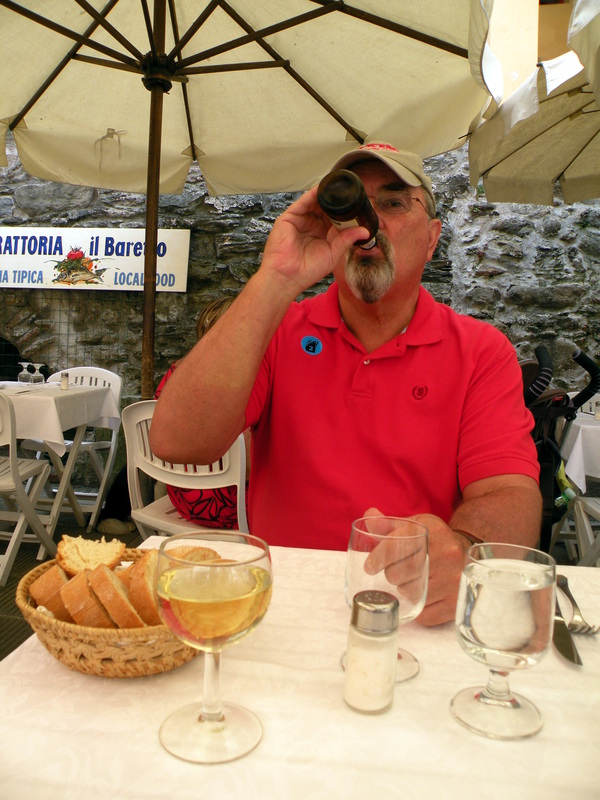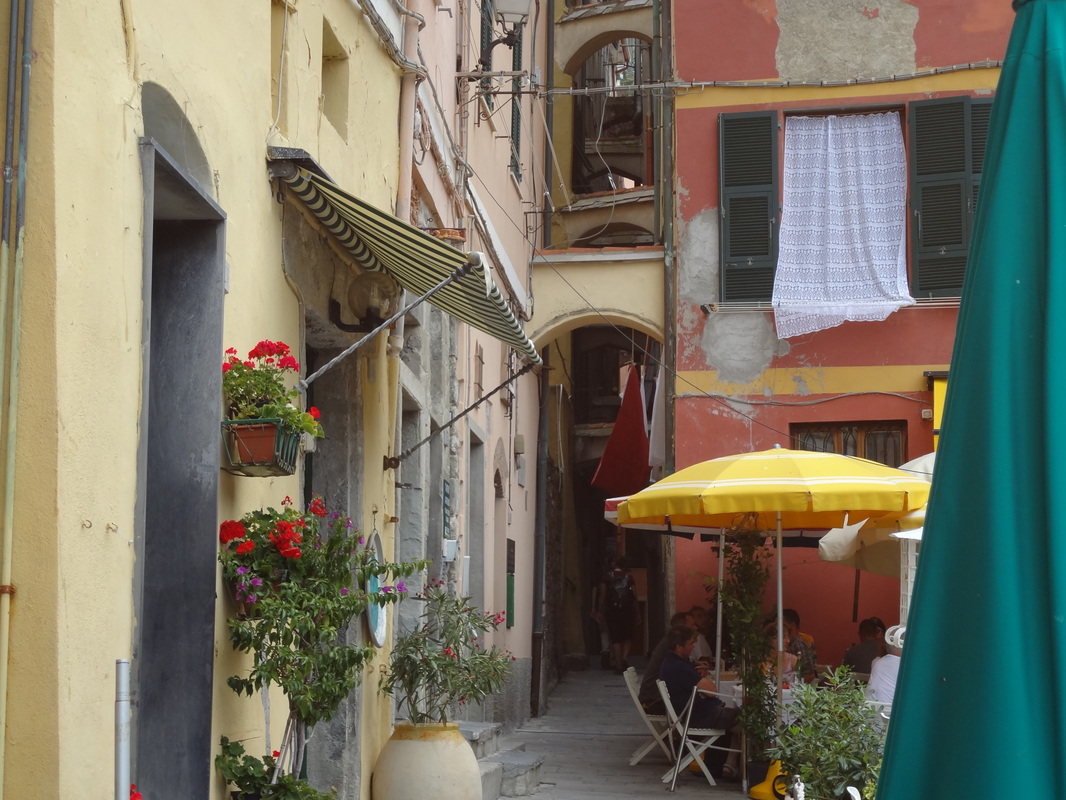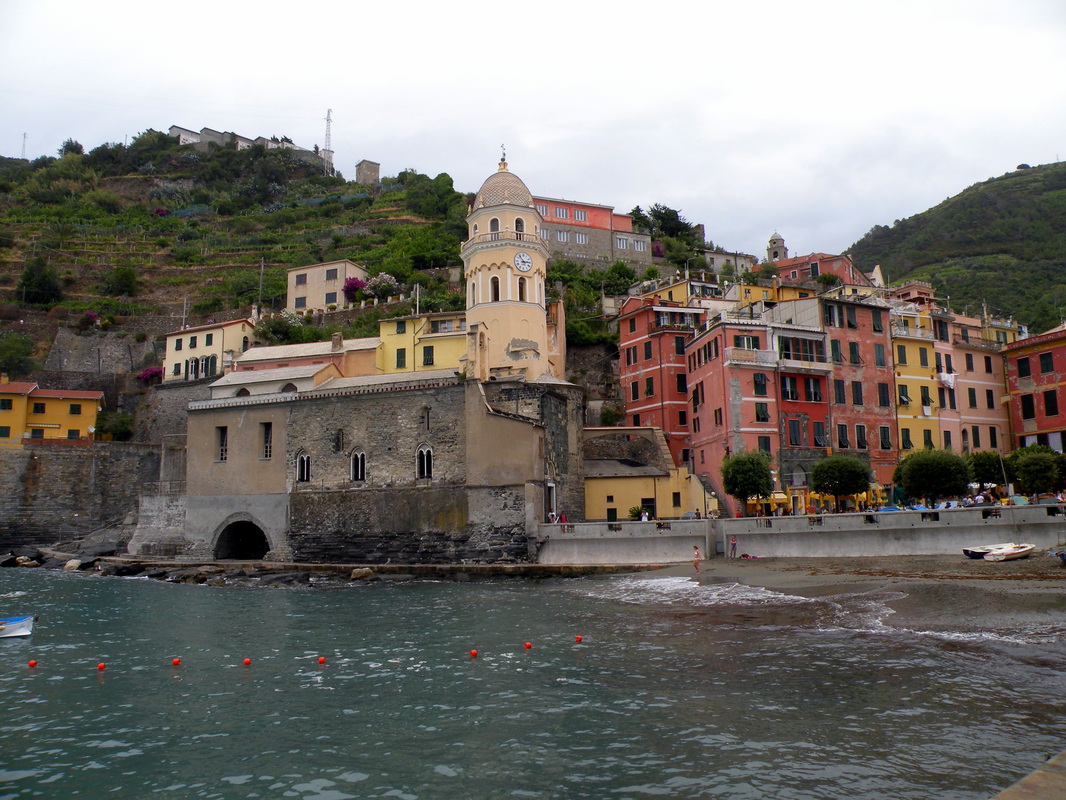Beautiful Vernazza
From the station in Vernazza, once again, the direction we headed was down, down narrow lanes to the sea. The steep seaside town which was founded around the year 1000, has the only proper harbor in the Cinque Terre and is a charming, small fishing village.
Vernazza was ruled by the Republic of Genoa starting in 1276. Its medieval castle, Belforte, towers above the harbor and was built in the mid-1500's, primarily to protect the village from pirates.
As we made our way, we made note of shops we wanted to stop into later and kept an eye out for a restaurant. We found a small festive trattoria with an outside seating area called Antica Osteria Il Baretto.
The choice proved to be exactly what we had hoped for. The friendly efficient waiter took our orders for the local pasta called Trofie made from chestnut or wheat flour and served with a pesto sauce. To drink, Jim of course had a beer, but I tried a glass of cold local dry white wine simply called “Cinque Terre”. They also produce a local sweet wine in the area called Sciacchetra, but I’m not a sweet wine girl, so I didn't try it.
Vernazza was ruled by the Republic of Genoa starting in 1276. Its medieval castle, Belforte, towers above the harbor and was built in the mid-1500's, primarily to protect the village from pirates.
As we made our way, we made note of shops we wanted to stop into later and kept an eye out for a restaurant. We found a small festive trattoria with an outside seating area called Antica Osteria Il Baretto.
The choice proved to be exactly what we had hoped for. The friendly efficient waiter took our orders for the local pasta called Trofie made from chestnut or wheat flour and served with a pesto sauce. To drink, Jim of course had a beer, but I tried a glass of cold local dry white wine simply called “Cinque Terre”. They also produce a local sweet wine in the area called Sciacchetra, but I’m not a sweet wine girl, so I didn't try it.
While we waited for our meal, we were entertained by the local flower merchants right next door. It seemed that it was not only a flower market, but a gathering place for the young men of the neighborhood. The men took turns sitting and standing on the steps to chat with their friends, and then would disappear into the lunch time activity.
As we watched the comings and goings at the flower market, we noticed the small shrine to Mary in an arched cave protected by a sunburst of white vertical iron bars bars spreading to a sunburst at the top . The grotto was almost hidden by the flower vases. A small statue of the Virgin could be seen in the dark recesses. At the other end of the restaurant was a long “NASE”, one of the famous Italian water spigots used for drinking and cooling off on a hot day. It protruded from the stone wall with a stone basin below. Since it was lunch time, the whole street bustled with local people doing errands and tourists darting in and out of shops.
As we watched the comings and goings at the flower market, we noticed the small shrine to Mary in an arched cave protected by a sunburst of white vertical iron bars bars spreading to a sunburst at the top . The grotto was almost hidden by the flower vases. A small statue of the Virgin could be seen in the dark recesses. At the other end of the restaurant was a long “NASE”, one of the famous Italian water spigots used for drinking and cooling off on a hot day. It protruded from the stone wall with a stone basin below. Since it was lunch time, the whole street bustled with local people doing errands and tourists darting in and out of shops.
Later, we followed the main street on downward until it widened at the bottom creating the Piazza Marconi, which was ringed by bars, cafés and restaurants where tables vied for space with the fishing boats lined up neatly in the square. Beyond this was a small curved crescent of sand beach sheltered by a long sea wall of concrete and large boulders.
At the far right, just before the cliffs began again, sat the church of Santa Margherita d’Antiochia, which has existed since at least the 13th century and sits on a 12th century foundation. The church was built because a box containing the bones of Santa Margherita was said to have been found on the beach there.
According to legend, the box of bones was lost during a storm centuries ago. You can feel the permanence of the sacred site as it rises out of its volcanic base. The older base of the church is built with the dark stone which gives way to pale grey stone brick and honey toned stucco halfway up the sturdy walls and is capped with a bright creamy octagonal tower added during renovations in the 16th and 17th centuries.
According to legend, the box of bones was lost during a storm centuries ago. You can feel the permanence of the sacred site as it rises out of its volcanic base. The older base of the church is built with the dark stone which gives way to pale grey stone brick and honey toned stucco halfway up the sturdy walls and is capped with a bright creamy octagonal tower added during renovations in the 16th and 17th centuries.
In stark contrast, across the piazza out on the sea wall vacationers perched on the concrete wall or jumped precariously from one large rock to another, occasionally caught by the sea spray that shot upwards propelled by the high rolling waves. Inside the protected area, the sea was smooth and calm and a few brave souls swam in the chilly water. Jim and I were content to watch all the holiday action while ensconced comfortably at the piazza edge enjoying a cool Italian beer under one of the bright yellow umbrellas of the Ananasso Bar.
Far above the ground on the opposite hillside we could see the towering dark stone sides of the Belfort Castle where the town defenders would have looked out for the marauding pirates who had plagued the coastline during the 1400’s. I left Jim sipping his beer and climbed around the point to see that now, in modern time tourists were sipping wine and eating a wonderful meal on the Belfort Restaurant terrace, enjoying the setting sun while seeing pirate ships only in their minds eye.
While I would have loved to linger, Jim and I had a date with a cruise ship that would not wait for us, so we met up with our group and boarded the bus back to the Nieuw Amsterdam. That night we would be sailing on to Civitavecchia our port of Rome.























